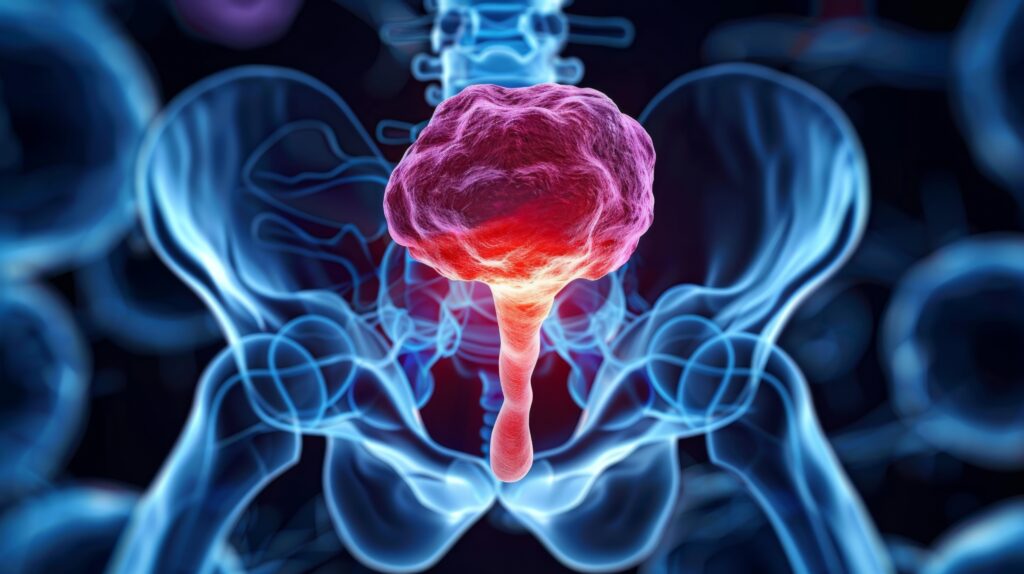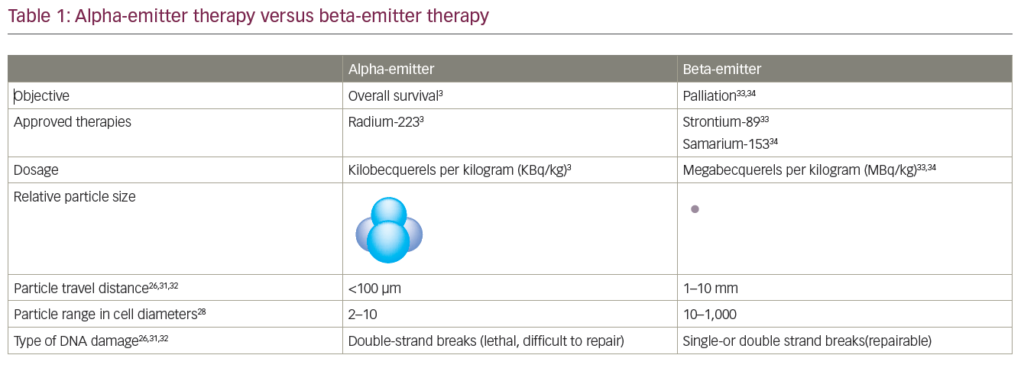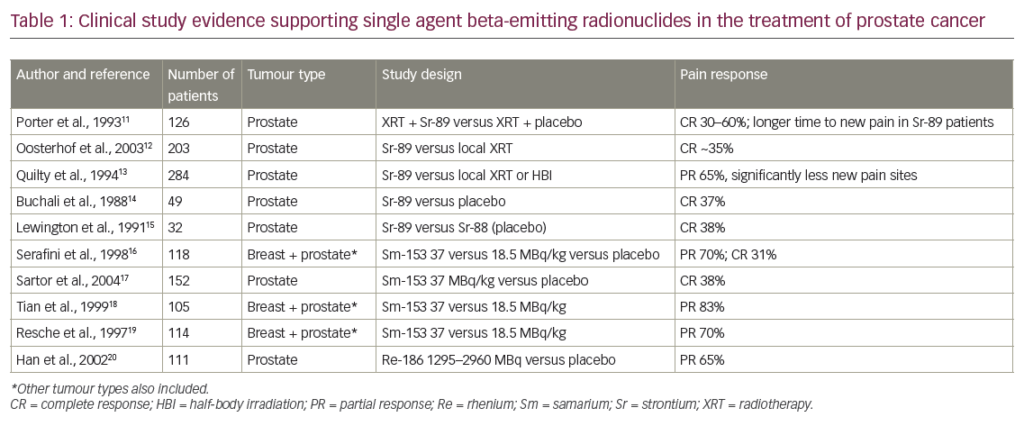In 2010, prostate cancer was the most commonly found malignant cancer in men, comprising 28 % of all new cancer cases.1 In the US, it is the second leading cause of cancer death in men, with annual mortality rates of approximately 30,000 deaths per year.1 Symptoms of the disease include: frequent and/or painful urination; difficulty in starting or stopping urination; changes in sexual function; and weight loss. Diagnosis of the disease is confirmed by biopsy. Factors that impact a patient’s prognosis include the stage of cancer (whether it is localised, locally advanced or metastatic), the Gleason score (a score system based on tumour morphology and histology) and the level of prostate-specific antigen in the blood. In the UK, approximately 20 % of men with primary prostate cancer present with incurable metastatic disease.2 Prostate cancer metastasises preferentially to bone,3 and metastatic bone disease is responsible for a significant proportion of morbidity and mortality associated with the advanced stages of this disease. During prostate cancer progression, activation of the androgen receptor (AR) by androgens such as testosterone and dihydrotestosterone stimulates cell proliferation and inhibits apoptosis in prostate cancer cells. The initial treatment of metastatic prostate cancer is androgen deprivation (castration) therapy and this is achieved through either surgical or medical castration. Over time nearly all patients with metastatic disease become resistant to androgen deprivation, progressing to castration-resistant prostate cancer (CRPC) which is usually fatal.
Development of Castration-resistant Prostate Cancer
There are multiple mechanisms that can drive disease progression to CRPC, and most involve the AR pathway.4 Resistance to castration therapy can be due to altered AR sensitivity, amplification of AR or mutations. Alternative splicing of the AR gene can lead to the expression of ARs lacking the ligand-binding domain and which are constitutively active. Additionally, CRPC can be caused by ectopic androgen synthesis, such as androgen synthesis by the adrenal glands, the tumour itself or increased conversion of extra-gonadal androgens to testosterone. Other mechanisms of progression to CRPC include modulation of AR co-regulators (again leading to increased signalling of the AR pathway) and, lastly, there can be activation of compensatory AR-independent pathways, which lead to cell proliferation and inhibition of apoptosis.
Current Treatments for Castration-resistant Prostate Cancer
Prior to 2010 docetaxel was the only approved agent for CRPC, and currently only three other systemic agents have demonstrated an increase in overall survival in patients with metastatic CRPC. Mitoxantrone, a type II topoisomerase inhibitor, has not demonstrated a survival improvement but remains a palliative therapeutic option.5 Currently, docetaxel plus prednisone every three weeks is the preferred first-line treatment for CRPC. Docetaxel is a well established anti-mitotic chemotherapy agent and in the TAX 327 Phase III clinical trial was shown to confer an overall survival advantage of three months, when compared to mitoxantrone.6,7 A study by the Southwest Oncology Group showed a similar survival benefit.8
In April 2010, the FDA approved the use of the immunotherapy sipuleucel-T for men with less advanced disease. Treatment with sipuleucel-T is only recommended for patients with a good performance level, and not those with symptomatic, rapidly progressive or visceral disease. Sipuleucel-T is an autologous cancer vaccine, produced by exposing the patient’s antigen-presenting cells (APCs) to a recombinant fusion protein (PA2024), after first being collected from the patient’s white blood cell fraction.9 PA2024 is a prostate antigen, prostatic acid phosphatase, fused to granulocyte macrophage colony-stimulating factor (an activator of immune cells). The activated APCs are then re-infused back into the patient. In a Phase III clinical trial the sipuleucel-T treatment arm was shown to extend the mean survival by 4.1 months as compared with placebo.10
Cabazitaxel (plus prednisone) also gained approval by the FDA in 2010 as a therapeutic option for patients who have previously failed docetaxel-based chemotherapy.11 Cabazitaxel is a semi-synthetic taxane derivative with antimitotic activity. Approval was based on the results of a Phase III trial comparing cabazitaxel with mitoxantrone, with a 2.4-months improvement in overall survival seen in the cabazitaxel treatment arm (HR 0.72, p<0.0001).12 Treatment caused a high rate of grade 3–4 neutropenia, that was observed in 81.7 % of patients in the cabazitaxel treatment arm.
In 2011, the FDA approved the use of abiraterone acetate plus prednisone for patients with metastatic CRPC who have previously been treated with docetaxel. Abiraterone is an androgen synthesis inhibitor, and selectively and irreversibly inhibits both the 17α-hydrolxylase and the C17,20-lyase function of the enzyme cytochrome P450 c17.13 This is a key enzyme required for the synthesis of testosterone/dihydrotestosterone from weak adrenal androgens.14 A Phase III, randomised, placebo-controlled clinical trial demonstrated a statistically significant improvement in overall survival in patients treated with abiraterone (14.8 months versus 10.9 months in the abiraterone and placebo treatment arms, respectively).15
Castration-resistant prostate cancer is now the second most common cause of male cancer-related mortality in the US.1 Although several treatments have been shown to extend the survival of patients, subsequent treatment options remain limited, and current approved therapies have only been shown to provide a four-month overall survival advantage at best.6,10,12,15 New therapies are needed to both extend patient survival and improve patient quality of life. Additionally, new treatments are required for therapeutic intervention prior to CRPC development. The current first-line treatment for prostate cancer is a combination of radiotherapy, radical surgery and hormone therapy. Surgery and radiotherapy are generally effective but often have undesirable effects including incontinence and loss of sexual function.16 Hormone (castration) therapy acts in one of two ways: either blocking the release of luteinising-hormone releasing hormone (LHRH) through LHRH agonists such as leuprolide (Eligard®, Lupron®, Viadur® and goserelin [Zoladex®]), or through anti-androgens such as bicalutamide (Casodex®). However, hormone therapies are also associated with undesirable side effects including impotence, tumour flare and loss of bone mass.17 Some of these side effects are due to the fact that castration therapy, in addition to abolishing the receptor-dependent signalling pathways, also inhibits the receptor’s transcriptional action which affects positive actions of androgens such as neuroprotection and bone preservation. In principle, new therapies could be developed that are more specific, abolishing receptor-dependent signalling but preserving AR transcriptional action.
Src Inhibitors as a Potential Treatment Option for Prostate Cancer
The Src family kinases (SFKs) have emerged as important targets in cancer therapy.18 Src is a non-receptor tyrosine kinase and has an important role in tumour development and bone metabolism. Src signalling is particularly important in prostate cancer, where bone is the usual site of metastatic spread.3 Increased Src activity or expression has been reported in prostate cancer tissue and cell lines,19–21 and levels of Src have been found to be highest in tissue specimens from patients with CRPC.21 Proliferation in response to androgen involves Src signalling,22,23 and a number of studies have demonstrated that inhibiting Src activity strongly reduces prostate cancer growth.24–27 Additionally, there is also evidence that Src may be involved in the transition from castration-sensitive to CRPC.25,28 Because metastatic bone disease is responsible for a significant proportion of morbidity and mortality associated with advanced prostate cancer, treatment strategies that inhibit tumour activity and osteoclast activity could be beneficial in treating advanced CRPC.
There are several Src inhibitors in development that have shown preclinical activity against prostate cancer cells and these include: dasatinib; saracatinib; AZM475271; CGP76030; CGP77675; PD180970; and KX2-391. The majority of Src inhibitors are in Phase I or preclinical development, however dasatinib is currently approved for treating patients with myelogenous leukaemia and as a second-line treatment for patients with Philadelphia-chromosome-positive acute lymphoblastic leukaemia. Dasatinib is a multitargeted inhibitor of receptor tyrosine kinases, and its main targets include Bcr/Abl, Src, C-Kit and the ephrin receptors along with several other tyrosine kinases.29 Saracatinib (also known as AZD0530) is another Src inhibitor that is further along the developmental pipeline and is an orally active multitargeted inhibitor of Src, Yes, Lck and Bcr/Abl. Saracatinib has been shown to inhibit Src in a dose-dependent manner, and inhibit proliferation and migration in a range of prostate cancer cell lines,24 however in a Phase II trial treating patients with advanced CRPC, saracatinib showed little clinical efficacy as a monotherapy.30
The majority of the current Src inhibitors in development are either multitargeted (and also inhibit other receptors) or completely inhibit all Src activity, or both.31 The exception to this is VAL 201, a novel deca-peptide that is currently under development for the treatment of CRPC. VAL 201 specifically targets AR-associated/activated Src, leaving Src activity and DNA synthesis unaffected in AR-negative cells, and is the first example of a specific inhibitor of steroid-receptor-dependent signal transducing activity.
Overview of the Mechanism of Action of VAL 201
In human mammary and prostate cancer cells, steroid hormones or epidermal growth factor (EGF) trigger association of the AR-estradiol receptor (ER) complex with Src, which activates Src and affects the G1 to S cell cycle progression (see Figure 1).22 VAL 201 inhibits this interaction, and the subsequent activation of the AR or ER, inhibiting steroid- and EGF-dependent DNA synthesis.26 Most importantly, inhibition of Src by VAL 201 takes place after androgen binding, and allows inhibition of growth but does not block desirable receptor-dependent transcriptional activity. This difference should eliminate the majority of side effects that are associated with androgen therapies. VAL 201 works by mimicking the amino-acid sequence responsible for human AR interaction with Src, and has been demonstrated to suppress tumour growth in tissue culture and the growth of LNCaP prostate cell xenografts in nude mice.26 VAL 201 does not inhibit the S phase entry and cytoskeletal changes in AR-negative prostate cancer cell lines induced by EGF or serum treatment.
Preclinical Studies
As previously mentioned, VAL 201 has been shown to be highly effective against prostate and breast cancer cell lines and mouse xenografts.26 The in vitro half-life for VAL 201 in human liver microsomes was 49 minutes, classified as intermediate metabolic clearance, and in human plasma the half-life of the peptide was 95 minutes (personal communication with Dr George Morris). An oral formulation of VAL 201 peptide is being developed by incorporation into nanoparticles that are released in the upper GI tract. The peptide has also been shown to be stable at low pH. VAL 201 has been evaluated in LNCaP prostate cancer cells in vitro and in a xenograft model at nanomolar concentrations (see Figure 2).26 The control treatments, vehicle and scrambled peptide, showed no inhibition of xenograft development demonstrating the specific activity of VAL 201. In another study, a reduction of cell proliferation was seen in hormone-responsive and -refractory cells with no overt chronic toxicity effects (see Figure 3).
As noted earlier, hormone therapies are associated with undesirable side effects including impotence, hot flashes, gynaecomastia, increase in body fat, osteoporosis, decrease in muscle mass, depression and fatigue.17 These side effects can significantly affect quality of life. The current first-line chemotherapeutic treatment for CRPC is docetaxel which is a cell cycle specific agent, and thus cytotoxic to all dividing cells in the body. Because of this, side effects such as alopecia and neutropenia are common.32 Owing to the mechanism of action of VAL 201, this peptide is potentially less toxic than other first choice therapeutic options for prostate cancer. Additionally this peptide is being developed into an oral formation and has a good pharmacokinetic profile in vivo.
To further evaluate VAL 201 as a therapeutic option for the treatment of prostate cancer, the following clinical studies have been proposed. Firstly, a microdosing study is being considered so that at an early stage of clinical development good human pharmacokinetic data will become available. However, the option to dose pre-prostatectomy patients is being contemplated, and this would give access to biopsy samples for subsequent targeting analysis. The clinical development programme of VAL 201 is currently at the planning stage.
Future Developments
VAL 201 is equally efficacious in androgen-AR and estradiol-ER modulation, and this opens up a range of potential disease targets beyond prostate cancer. There is significant potential for the use of VAL 201 as a treatment for other metastatic cancers including breast, endometrial and ovarian cancer, but its development for these indications is at an early stage. Preclinical testing, has demonstrated that VAL 201 inhibits the estradiol-induced association between the ER and Src without interfering in receptor-dependent transcriptional activity in MCF-7 mammary cancer cells.26
Another potential role for VAL 201 in the future is an alternative to chemical or surgical castration in patients with low-risk prostate cancers. Upon diagnosis of low-risk early stage prostate cancer, an ‘active surveillance’ approach is currently adopted due to the risk/benefit considerations of available drugs. Active surveillance refers to a strategy of forgoing immediate treatment after a diagnosis of prostate cancer in favour of regularly scheduled testing and clinical examinations to monitor disease progression. Many patients are unhappy about a perceived lack of treatment after being diagnosed with cancer and forgo active surveillance, opting for surgical or chemical therapies with undesirable side effects. The theoretically favourable safety profile of VAL 201 means that it could potentially be prescribed at this stage to delay disease progression. Because VAL 201 is a novel therapy, there is the potential for combinational activity with other anti-cancer agents. Synergy of the Src inhibitor dasatinib has been demonstrated in non-prostatecancer models for cisplastin, doxorubicin and temozolomide,33–35 and therefore there is potential for VAL 201 to demonstrate combinational activity.
The median survival for patients with metastatic castration-resistant prostate cancer with the recommended available treatments is approximately 18 months, and there is an urgent unmet need for more effective therapies. VAL 201 is the first example of a specific inhibitor of steroid-receptor-dependent signal transducing activity and this represents a novel and exciting approach for cancer chemotherapy. It has the potential to become an important and effective treatment option for patients with CRPC and may also facilitate therapeutic intervention at the early stages of prostate cancer. The clinical development of this drug will be watched with great interest by the entire oncology community and patients alike. ■















